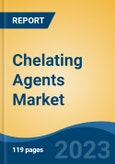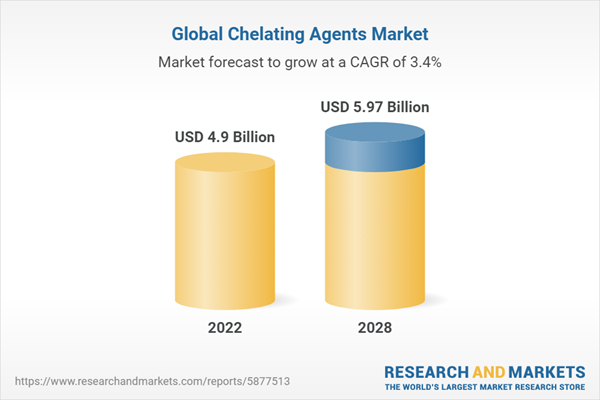Speak directly to the analyst to clarify any post sales queries you may have.
10% Free customizationThis report comes with 10% free customization, enabling you to add data that meets your specific business needs.
Chelating agents refer to molecules capable of forming multiple bonds with a single metal ion, resulting in the formation of chemical complexes known as chelates. These compounds play a vital role in various industries, including consumer goods, agrochemicals, water treatment, domestic and industrial cleaning, pulp and paper, and cleaning products. They are utilized in textile and paper pulp bleaching processes to stabilize peroxide solutions. Moreover, chelating agents find application in the removal of metals from industrial effluent by adjusting pH, with or without the addition of sulfide, carbonate, phosphate, or carbamate.
The market for chelating agents is witnessing rapid expansion, primarily propelled by the growing demand from end users in the cleaning and detergent sector. Furthermore, the water treatment chemicals market is experiencing increased demand, along with a swift expansion in the paper and detergent sectors, which plays a crucial role in driving market growth. However, environmental concerns related to toxicological risks are expected to restrict market expansion during the forecast period.
Currently, chelating agents are extensively used in the reprocessing of fibers into bleached wood pulp, which serves as raw material for newsprint and toilet tissue production. Additionally, these compounds are increasingly used in commercial and domestic cleaning products to remove hard water and metal oxide deposits, owing to the rising awareness about surface cleanliness and hygiene. Moreover, advancements in chelating technology are facilitating the development of mobilizing agents, which aid in the removal of industrial waste and minimize the adverse effects of hazardous chemicals on the environment.
Furthermore, chelating compounds are employed in synergy with other chemicals in upstream oil and gas applications, including acidizing, filter cake removal, wettability alteration, reservoir productivity enhancement, and improved oil recovery from sandstone and carbonate reservoirs. The thriving oil and gas industry presents lucrative growth opportunities for companies operating in this sector. Moreover, the market is expected to witness expansion in the coming years, driven by the increasing investments by major market players in various research and development (R&D) projects, with a focus on synthesizing novel biodegradable agents.
The growing demand from the pulp and paper industry continues to be a significant driver for market growth.
The pulp and paper industry heavily relies on the use of chelating chemicals, such as ethylenediaminetetraacetic acid (EDTA) and diethyleneetriamine pentaacetic acid (DTPA), in the bleaching process to effectively control the action of soluble metal ions without causing any build-up. Chelating agents are particularly utilized in bleaching chains, especially in the sodium hydrosulfite and chlorine dioxide processes, and they can also be employed for scaling and inking tasks. These agents have diverse applications, including water cleansing and chlorine exfoliation in manufacturing.
The paper and pulp industry, as the largest consumer of chelating agents, is expected to dominate the global market. Oxygen-based bleaching chemicals containing chelating agents are commonly used in pulp bleaching sequences. EDTA and DTPA are the two most frequently used chelating agents in this industry, and they are mass balanced and degraded in activated sludge plants, contributing to the overall growth of the global market for chelating agents. Chelates play a crucial role in treating mechanical pulps, as the heavy ions present in lignin can hinder the effectiveness of the bleaching process. Furthermore, chelates are used in combination with sodium hydrosulfite bleaching agents in mechanical pulping.
The market growth is primarily driven by the increasing demand for environmentally friendly or 'green' chelating agents. Many countries prioritize reducing toxicity and environmental impact, leading to a higher demand for green chelating agents. As consumer awareness expands, the market for biodegradable products continues to grow. Eco-conscious consumers prefer environmentally friendly products, and the favorable properties and low nitrogen content of green chelating agents attract several end users. The market welcomes greener alternatives that are more sustainable, aligning with advanced environmental protection regulations.
Considering that over 90% of organic compounds originate from refineries using non-renewable fossil fuels, it becomes crucial to seek alternatives to conventional chelating agents. With the depletion of petroleum supplies and a shift towards greener products, the demand for greener chelates is increasing. These greener alternatives offer good complex formation capacity and low nitrogen concentration, effectively replacing conventional chelates while reducing the nitrogen load. Such environmentally friendly chelates are ideal for compliance with stringent environmental protection laws.
The market growth is further driven by the increasing demand from various end-use industries, including textiles, paper, agriculture, food, personal care, water treatment, and mining. Chelating agents, as chemical compounds that form stable, water-soluble metal complexes by reacting with metal ions, enhance the overall stability and bonding ability of the metals with other substances. In agricultural applications, chelating agents play a vital role in delivering micronutrients like manganese, zinc, iron, and copper.
According to the United Nations (UN), the global population is projected to reach 9.7 billion by 2050, an increase of 2 billion people within the next 30 years from 2023. Additionally, chelating agent formulations serve as crucial raw materials in the production of various personal care products. Chelating substances are essential for improving the effectiveness, stability, and shelf life of cosmetic products.
Chelating agents, derived from renewable raw materials, are natural products with good biodegradability. They play a crucial role in the paper and pulp industry by eliminating and deactivating metal ions during the pulp bleaching process. The demand for chelating agents is projected to grow steadily in the coming years.
However, conventional chelating agents pose environmental concerns. These hazardous substances, such as heptonic acid and nitrilotriacetic acid, are commonly used in domestic and industrial settings. The presence of high levels of these chemicals poses a threat to drinking water and groundwater, impacting both the environment and living organisms. In fact, certain European countries, including Norway and Sweden, have already banned the use of EDTA and DTPA, due to their harmful effects on aquatic life.
Recognizing the toxicity of chelating agents, the United States Environmental Protection Agency (EPA) has classified them as highly toxic elements. Consequently, the commercial use of chelating agents requires various environmental clearances, adding to production and distribution costs. Moreover, price fluctuations in the global petrochemical market have further impacted these costs.
Overall, while chelating agents have important applications in various industries, it is crucial to address the environmental concerns associated with their use and explore more sustainable alternatives.
Recent Developments
- In March 2021, Dow Inc., a prominent U.S.-based commodity chemical company, entered into a partnership with Univar Solutions Inc., a distributor of chemicals and ingredients. This collaboration aims to deliver a portfolio of 13 brands in Brazil, including Aculyn, Versene, Ecosense, Cellosize, and Foamysense. The agreement focuses on providing sustainable and innovative chelating agents for a wide range of personal and beauty care products, such as shampoos, conditioners, body washes, and more.
- Furthermore, in March 2021, BASF SE signed two partnership deals with Holiferm and Allied Carbon Solutions Co., Ltd. These strategic partnerships aim to expand BASF SE's brand presence and product portfolio in industries such as industrial products, personal care, and home care. By collaborating with these companies, BASF SE aims to gain market share in various regions and enhance its commitment to sustainable manufacturing.
Market Segmentation
Global Chelating Agents Market is segmented based on type, application, region and competitive landscape. Based on type, the market is categorized into Aminopolycarboxylic Acid, Sodium Gluconate, Organophosphonate, and others. Based on the application, the market is segmented into pulp and paper, household and industrial cleaning, water treatment, agrochemicals, personal care, and others. Based on region, the market is divided into North America, Europe, Asia Pacific, South America, and Middle East & Africa.Market Players
Akzo Nobel NV, Archer Daniels Midland Company, BASF SE, Kemira Oyj, The Dow Chemical Company, Mitsubishi Chemical Holdings Corporation, Nouryon Chemicals Holding B.V., Lonza Group AG, Evonik Industries AG, Ascend Performance Materials LLC are some of the key players of the Global Chelating Agents Market.Report Scope
In this report, Global Chelating Agents Market has been segmented into the following categories, in addition to the industry trends, which have also been detailed below:Chelating Agents Market, by Type:
- Aminopolycarboxylic Acid
- Sodium Gluconate
- Organophosphonate
- Others
Chelating Agents Market, by Application:
- Pulp and Paper
- Household and Industrial Cleaning
- Water Treatment
- Agrochemicals
- Personal Care
- Others
Chelating Agents Market, by Region:
- North America
- Europe
- Asia-Pacific
- South America
- Middle East & Africa
Competitive landscape
Company Profiles: Detailed analysis of the major companies present in Global Chelating Agents market.Available Customizations
The following customization options are available for the report:- Detailed analysis and profiling of additional market players (up to five).
This product will be delivered within 1-3 business days.
Table of Contents
Companies Mentioned
- Akzo Nobel NV
- Archer Daniels Midland Company
- BASF SE
- Kemira Oyj
- The Dow Chemical Company
- Mitsubishi Chemical Holdings Corporation
- Nouryon Chemicals Holding B.V.
- Lonza Group AG
- Evonik Industries AG
- Ascend Performance Materials LLC
Table Information
| Report Attribute | Details |
|---|---|
| No. of Pages | 119 |
| Published | August 2023 |
| Forecast Period | 2022 - 2028 |
| Estimated Market Value ( USD | $ 4.9 Billion |
| Forecasted Market Value ( USD | $ 5.97 Billion |
| Compound Annual Growth Rate | 3.4% |
| Regions Covered | Global |
| No. of Companies Mentioned | 10 |









